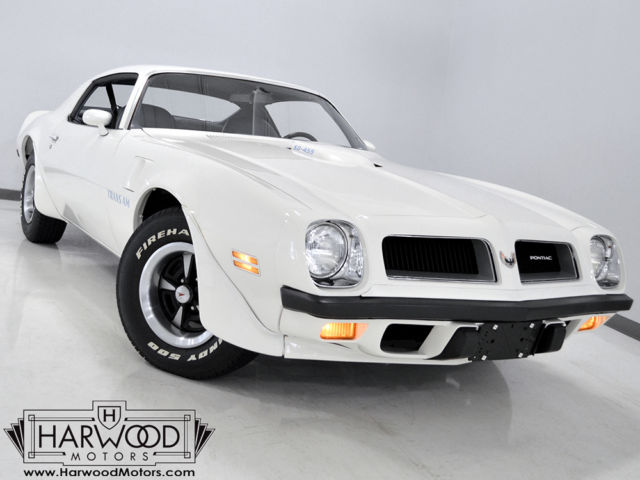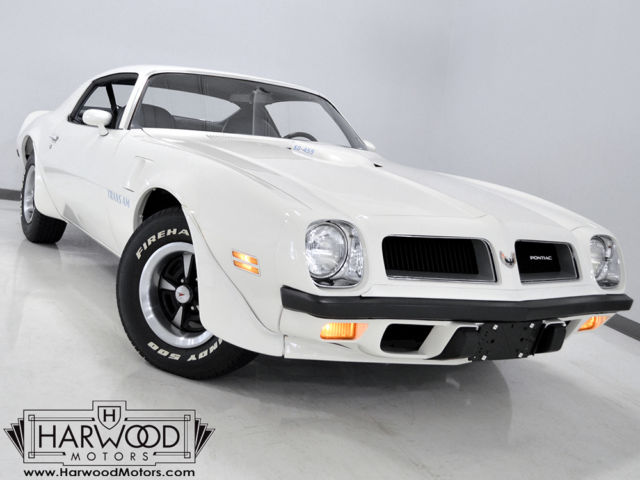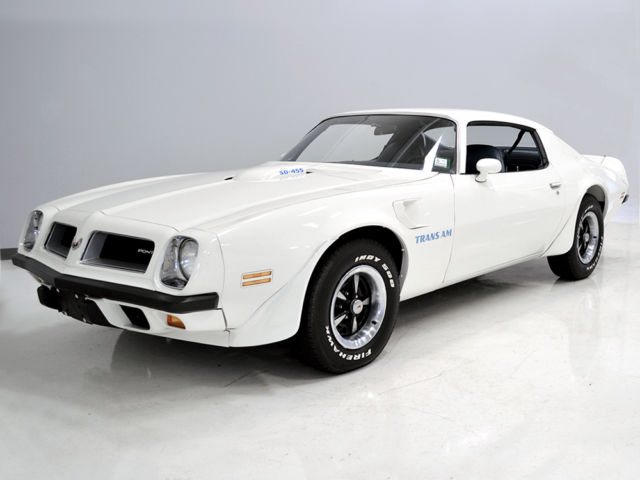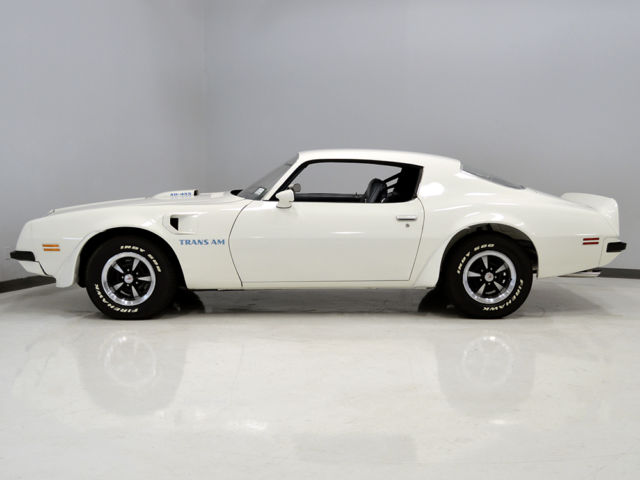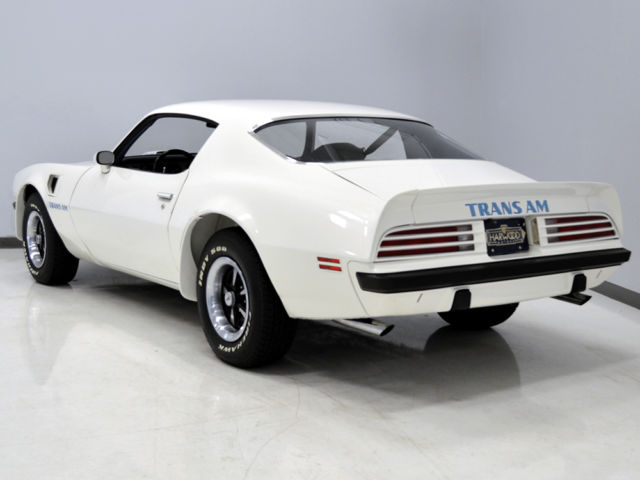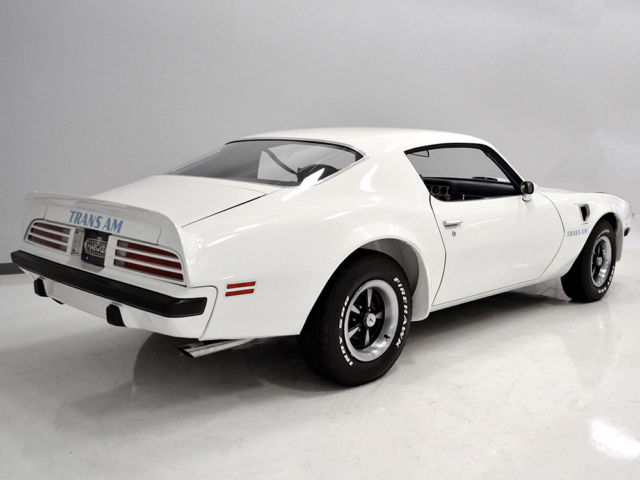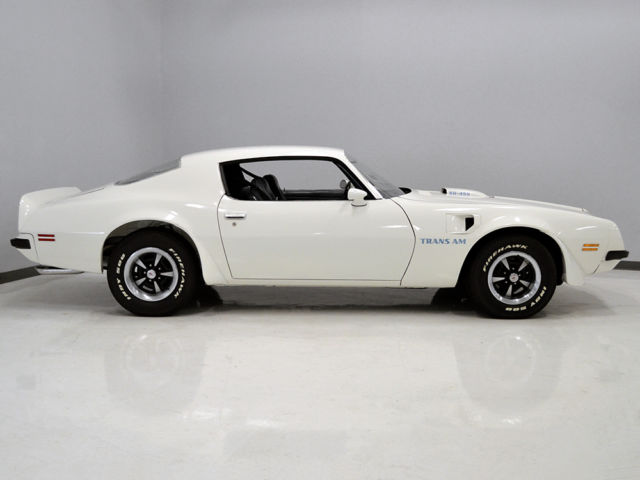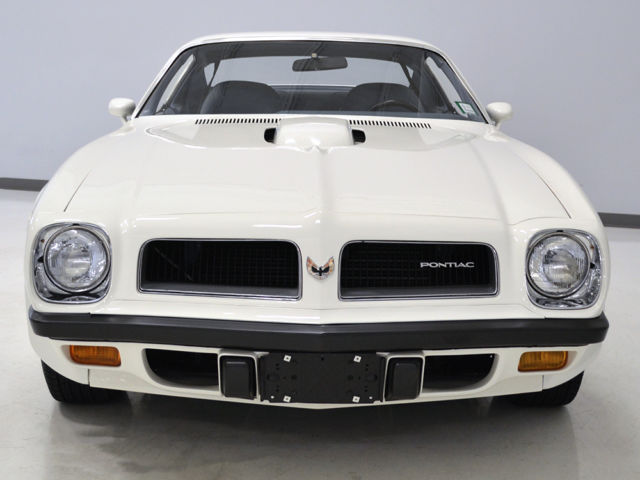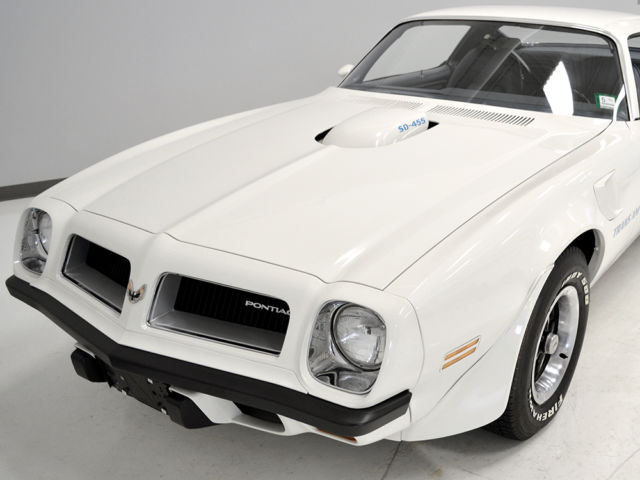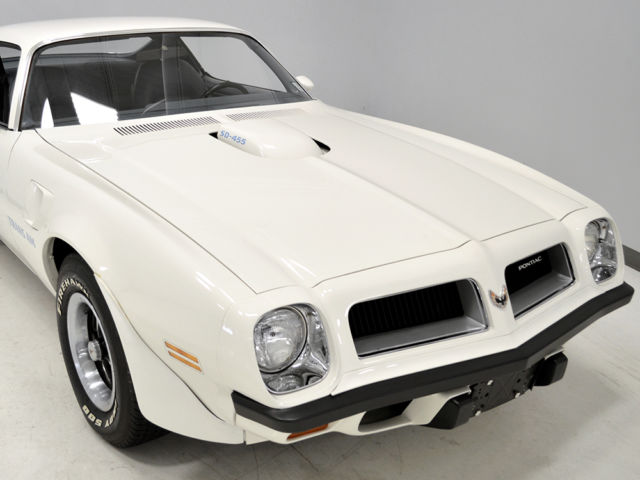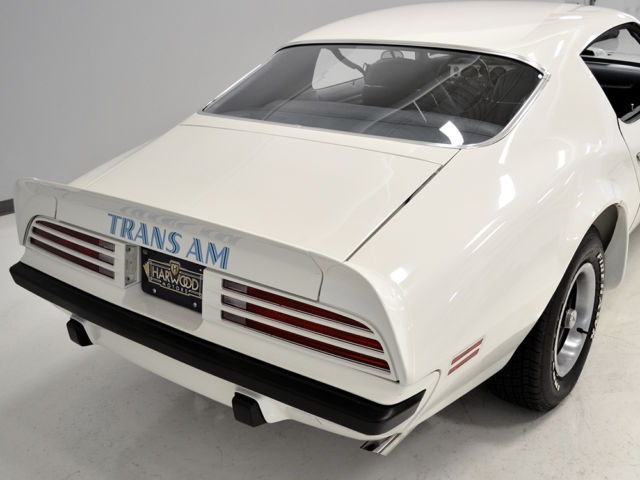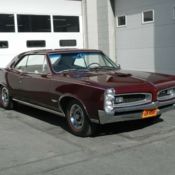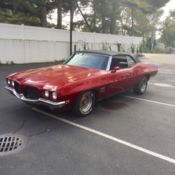40371 original miles, same owner since 1975, matching numbers, A/C.
Technical specifications of Pontiac Trans Am 1974
| Price: | - |
|---|---|
| Condition: | Used |
| Item location: | Macedonia, Ohio, United States |
| Make: | Pontiac |
| Model: | Trans Am |
| Year: | 1974 |
| Mileage: | 40,371 |
| VIN: | 2V87X4N123698 |
| Color: | Cameo White |
| Engine size: | 455 cubic inch V8 |
| Number of cylinders: | 8 |
| Interior color: | Blue Vinyl |
| Vehicle Title: | Clear |
| You are interested? | Contact the seller! |
Description
The Pontiac Trans Am Super Duty story is one of those that we love to hear. In the darkest days of emissions controls, oil embargoes, skyrocketing insurance rates, and a general neutering of horsepower, a few dedicated guys at the last known horsepower factory in America figured out how to get it done. Like the guys who snuck the COPO Camaros out the back door, the Pontiac engineers who tricked the Feds into thinking the Super Duty was just another 455 and thereby gave it life deserve our heartfelt appreciation. Despite sharing virtually zero parts with the garden-variety engine, it ended up on the options list during the most difficult time in history to build horsepower. Even more remarkable is the fact that it isn't some gelding engine and the Super Duty definitely deserves to be on the same platform as the all-time greats of the horsepower era. With 290 horsepower on tap, the Super Duty may not seem amazing from this side of history, but guess what Chrysler's Hemi would have put out when treated to the new "net" horsepower rating system—yeah, about 300 horsepower. The Super Duty is no joke.
This 1974 Pontiac Trans Am Super Duty is a special car that lives up to the legacy established by its special engine. Any Super Duty is a rare car, and this is one of only 943 Super Duty Trans Ams built and one of only 731 with an automatic transmission, but with only 40,371 original miles, this one is exceptional. It was purchased new by a Judge in Cleveland, Ohio from Lou Meliska Pontiac. The Judge drove it for only a year, using it to commute to Washington (hence the Baltimore parking permit still on the windshield) for official business. However, he ultimately realized that a big block muscle car wasn't the best choice in the days of long lines at gas stations and skyrocketing prices, so he sold it in 1975. That second owner's name is on the title today. Yes, that's right, he's owned this incredible car for more than 42 years. The car has been freshened a bit, most notably with a repaint in 2002, but it has never been fully blown apart for a restoration and the engine has never been opened, so it feels very much as it did in 1974. As with all truly original cars, there's an intangible feeling of solidity and quality that no restoration, no matter how thorough, can recapture. This is a very special car.
Code C Cameo White is this car's original color, so when the time came for a respray, there was no question what color they'd use. Given the car's care, mileage, and overall condition, the freshening didn't require any major surgery save for repairs to the bottom of one of the doors and one or two patches in the quarters, but no wholesale panel replacement. It had been used, not abused. The bare-metal respray was done with an eye towards authenticity, so single stage paint was selected as it would most closely mirror the original General Motors enamel. It was sanded and buffed, but not to perfection, leaving enough texture in the finish to convince onlookers that they were looking at vintage 1974 paint. The illusion is extremely convincing and if I had instead told you that this was original paint, even the experts would probably believe me. There are no tape lines, no botched bodywork, no evidence of repairs, although I might suggest that the gaps are probably better than they were back in 1974. Either way, the car looks exactly right.
You'll note on the window sticker and build sheet that this car was originally ordered with the $55 hood decal, but following the repaint they decided to leave it off. It was optional, so there's no demerit in not having it, and should you want one, reproductions are inexpensive (we'll even install one for you if you're heart-set on having the 'Bird on your hood). The other decals, including the Trans Am emblems and all-important SD 455 callouts on the hood scoop are as they should be. The rubber air dam and flares around the rear fenders are original and were not repainted, so they don't quite match, but then again, they didn't match when they were new. Much of the weather-stripping was replaced, but it retains all its original glass. The Firebird emblem on the nose is also original and a little deteriorated—we have a replacement but we like the authenticity of the original stuff a lot better. This car is not about perfection, it's about preservation.
The blue bucket seat interior is 100% original, including the carpets, and shows you what nearly five decades of care can do. Sure, there might be some light fading on the carpets and dash pad, but it's quite minor, there's a scuff on the driver's door, and the driver's seat might have some comfort marks, but there are really very few nits to pick inside this car. You'll quickly spot the long list of options that came with this car, including factory A/C, power windows, an 8-track player, and a center console. It's neat to see the little Firebird emblems on the front doors, which were Pontiac's way of saving money—they're the same door panels as the crank windows so the emblems were used to hide the hole. As a Trans Am, the Super Duty also received the beautiful engine-turned dashboard full of round analog gauges as well as a cool 3-spoke leather steering wheel. The gauges are all fully operational save for the oil pressure gauge, which seems to be pinned at the high end of the scale. I don't know if you have any 8-track tapes laying around, but that's another neat '70s feature that makes this car special. I'm guessing that nobody's ever been in the back seat, as the upholstery looks brand new and the trunk is still outfitted with its original mat, jack assembly, and unused original spare with inflator bottle!
But the real reason this car is special is under the hood, where you'll find the original Y8 coded 455 cubic inch Super Duty V8. The stories you've heard about these engines are largely true—they were virtually hand-assembled from the best parts. The block is unique, not interchangeable with a standard 455, offering 4-bolt mains, extra reinforcements, and even provisions for dry-sump oiling (although the production Super Duty had an oil pan sump). A heavy-duty cast crank and forged rods that were shot-peened and heat-treated for durability, plus a set of forged aluminum TRW pistons, meant that the Super Duty's rotating assembly more than lived up to its name. With 8.4:1 compression, it remained pump-gas friendly, and you know it was a challenge to get all that horsepower out of it with so little squeeze. To address that, Pontiac engineers selected round-port heads that were custom ported by Air Flow Research, a giant 800 CFM Quadrajet carburetor, and header-style exhaust manifolds all designed to get air in and out of the engine as quickly as possible. You've never driven a big block that revs like this!
The engine has never been apart, but it was detailed while the car was being painted and like the bodywork, special care was taken to preserve originality and keep it looking as authentic as possible. There's Pontiac Turquoise engine enamel on the block and heads, the giant air cleaner is fitted with new rubber (you'll note the block-off plate on the scoop has been removed which makes a tangible improvement in performance), and there are new soft parts throughout which all use correct clamps to hold them in place. All the fasteners are original and fittings for the A/C system are original. The alternator is correctly date-coded and the A/C system has been serviced and upgraded to R134a refrigerant. Turn the key and it fires quickly and idles nicely, even when cold, a good indication of careful tuning at work. On the street, there's a big swell of torque available at virtually any speed and even with an automatic and highway-friendly gears, this sucker feels like it wants to run. Trundling around town is OK, but it's not what the Super Duty wants to do. Nevertheless, we remain impressed that they were get such an engine onto the streets at all and to make it this user-friendly is quite a feat.
Automatic cars received the same engine as 4-speed machines, but they differed in the rear gears, where automatics with A/C got 3.08 cogs to minimize wear and tear on the A/C compressor. The TH400 is virtually bulletproof and this is the car's original transmission. This car was fully undercoated when it was new, which did great things for preserving the floors, but it was messy, so during the repaint the bottom of the car was painstakingly cleaned, removing all the sticky black tar and leaving the original finishes and sheetmetal intact. That's original red oxide primer, although it has been clear-coated to keep it looking fresh virtually indefinitely. A new exhaust system with a proper transverse muffler was installed, there are new shocks at all four corners, all the lines and hoses are fresh, and pretty much anything you need to service was serviced to put this Super Duty in top condition. There's a limited slip in the heavy-duty 10-bolt rear end and it's still correctly tagged. Factory Rally II wheels with polished trim rings were standard equipment, with this one wearing 225/70/15 Firestone radials in place of the original GR70x15s.
Very nicely documented with PHS paperwork, window sticker, original manuals, and a stack of receipts for maintenance and restoration work, this is a Super Duty with a bulletproof pedigree and an awesome history.
If you like cars with a story to tell, the Super Duty is a great choice. The fact that it even exists is somewhat of a miracle, and you'll own one of the very nastiest of all the muscle cars—just one that happened to be built a little bit after the day of the muscle car had ended. How cool is that?
